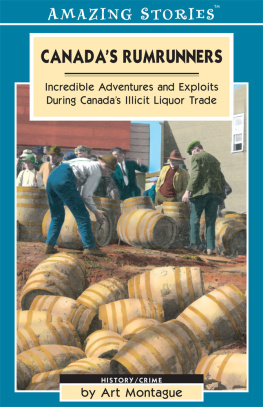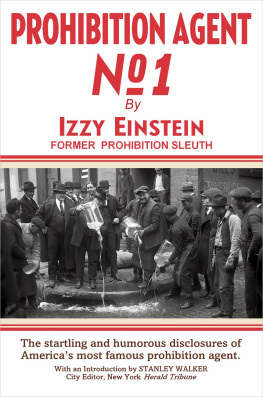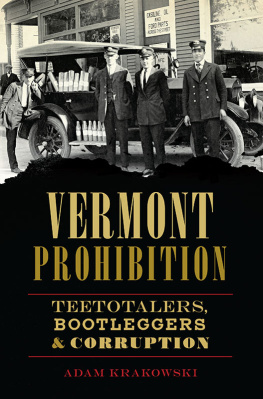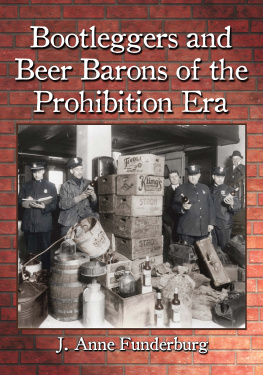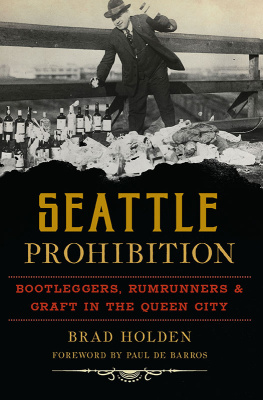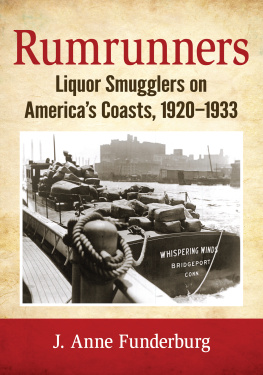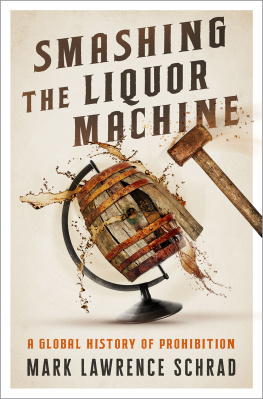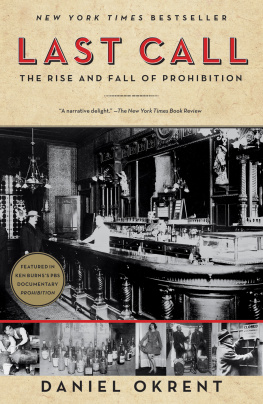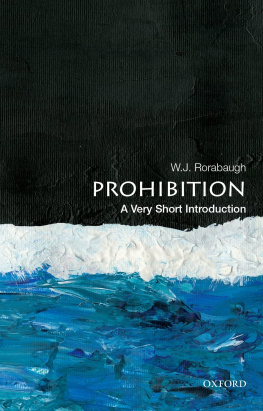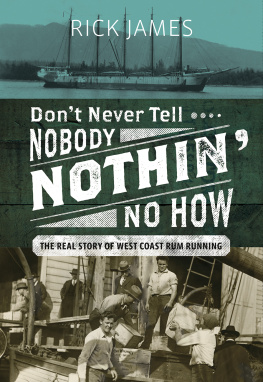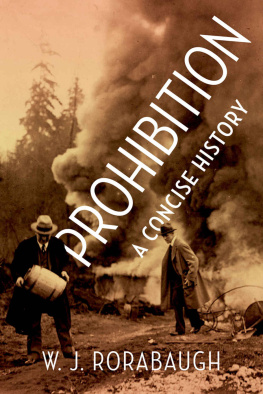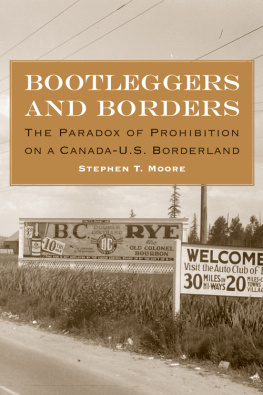Dedication
In memory of my maternal grandfather, the late Christopher Fulcher, who helped to keep the Whisky Sixes running the roads of Saskatchewan.
Prologue
On a quiet spring night in 1921, Ontario sailor George Woodward eased his 30-foot cabin cruiser, Le Voyageur II , into the Canada Customs dock at Belleville. It was midnight, and the government dock was deserted. George, who had already hauled three loads of bourbon across Lake Ontario that week, was eager to load another 200 cases and be on his way. But he would have to wait until dawn.
George moored his boat in the shadow of a decrepit steamship called the City of Dresden . Eyeing the old steamship, he couldnt help but envy John McQueen, her skipper. The Dresden could carry 4000 cases of whisky on a single run, a payload that made Georges efforts seem nickels and dimes. Still, his nickels and dimes were adding up fast.
After securing Le Voyageur II , George walked into town to while away the remainder of the night. Like most rumrunners, he had money lots of money by his standards, and certainly enough to buy a few drinks and play some cards at a blind pig (Canadian term for speakeasy).
In the early morning light, George got back to the dock just as a small yard engine was shunting two boxcars onto the government siding by the wharf. The boxcars were full of whisky from the Corbys distillery a few kilometres away. Pleased at his timing, George began to load his boat.
Suddenly, police bounded down the gangplank of the City of Dresden , where they had been hiding in the cabin. Before George had a chance to even question what was going on, he was handcuffed and informed that he was under arrest. To top it off, his boat and cargo were seized.
George was beside himself. More than that, he was enraged. His Canada Customs export papers were in order, indicating his shipment was consigned to a buyer in Mexico. The appropriate excise tax had been prepaid by the distillery. As far as Canadian federal law went, everything was on the up-and-up. But the police didnt care about the federal law. They were charging him under Ontario liquor laws, alleging he intended to sell the whisky in Ontario. Now that was illegal!
The stage was set for the most significant rumrunner trial in the Canadian history of Prohibition. If the Province won the case, rumrunning by small boats and cars would virtually end, and Canadian distilleries would lose up to 80 percent of their market. None of that concerned George. He was being wronged. He wanted his boat back. And he wanted his booze back.
In court, George readily admitted he was smuggling the bourbon to the United States. To prove it, two American bootleggers took the stand and testified theyd hired George to do the smuggling. Not only that; they had loaned him the money to buy his boat and had paid the distillery for the whisky through a shell company in Mexico.
The distillery plant manager then took the stand and confirmed the whisky had been sold to the Mexican company in accordance with Canadian law and was in no way a violation of U.S. law.
Canada Customs officials testified that Georges export papers were in order and that his export taxes had been paid in full. How his 30-foot cabin cruiser could make it to Mexico was never at issue, and what he did with the cargo once it left the government wharf was not Canadas business as far as the federal government was concerned.
Magistrate S. Masson took a few days to mull over his verdict. Finally, in his wisdom, he affirmed that while George was admittedly a smuggler, he had broken no Canadian laws. He found George not guilty, and went on to say, There is no burden cast upon us to enforce the laws of the United States.
By 1922, the floodgates were open for Canadian rumrunners. The Masson decision effectively turned a ripple into a tidal wave of whisky, and riding right on the crest, of course, were the 200 cases of George Woodwards cargo, which the magistrate ordered be returned to him immediately.
Chapter 1
Going With the Flow
George Woodwards court case may have had a different outcome if the Canadian distillers and American bootleggers hadnt dug deep into their pockets to hire his lawyers. They recognized that far more hung on the judgement than recovery of a boatload of booze, a small load at that.
Unless youre a lawyer, the ins and outs of complex laws can be confusing. As the George Woodward case showed, these complexities can sometimes be worked to advantage. Without these loopholes, wide enough for the safe passage of liquor-laden armadas of steamships and schooners, Canadian rumrunners would have been far fewer and far less successful.
How then, did such a mess, or depending on ones perspective opportunity, come about in the first place? What legislative absurdities allowed 100,000 Canadians to prosper on the fringe of legality, to say nothing of enabling two Canadian families to build international liquor empires that to this day rank among the largest in the world?
200 Years of Temperance
Weaving the tangled web went way back. By the time the first Canadian rumrunner charted his course for American shores, efforts to enforce the prohibition of liquor sales had a long history on the continent. The first attempt was in the Georgia colony in 1733. For the next nine years, rumrunners based in the neighbouring Carolinas ran so much liquor into Georgia that consumption went unchanged and lawlessness attributed to alcohol increased. Not surprisingly, the Georgia law was rescinded in 1742. Nevertheless, the seeds of legalized temperance were sown but so were the seeds of rumrunning.
Things were cool for a time. Here and there, employers decreed that employees must be non-drinkers. Beyond that, there wasnt much action until the late 1820s, when the temperance movement began to organize itself. Starting from church pulpits and eventually spreading to public rallies, temperance advocates declared liquor to be the devils design, an affront to God and family Gods will and family values were powerful arguments in those days.
In 1858, one of the U.S.s largest distillers, Hiram Walker, dismantled his equipment and moved his operations from Detroit to Windsor. Walker couldnt exactly sneak across the Detroit River in the dead of the night. He had to endure the rabble-rousing of gleeful temperance supporters, all of whom were crowing victory, delighted to see a perceived nemesis cut and run. But this temperance victory proved to be as hollow as an empty whisky keg. During the years of full Prohibition in the United States (19201933), the Hiram Walker distillery supplied the rumrunning pipeline with tens of thousands of gallons of whisky. From the companys point of view, their move to Canada was fortuitous.
Michigan was the state that led the way to full Prohibition in the U.S. By 1911, state legislators were so divided amongst themselves on the issue that they foisted responsibility on the counties, allowing each county to vote wet or dry. By the end of the year, 46 of the states 83 counties were dry. Then, in 1917, full Prohibition what some called the Noble Experiment truly got underway when Michigan enacted the Damon Law. This new law revoked the counties right to choose between wet or dry by outlawing saloons and other retail liquor sales.

